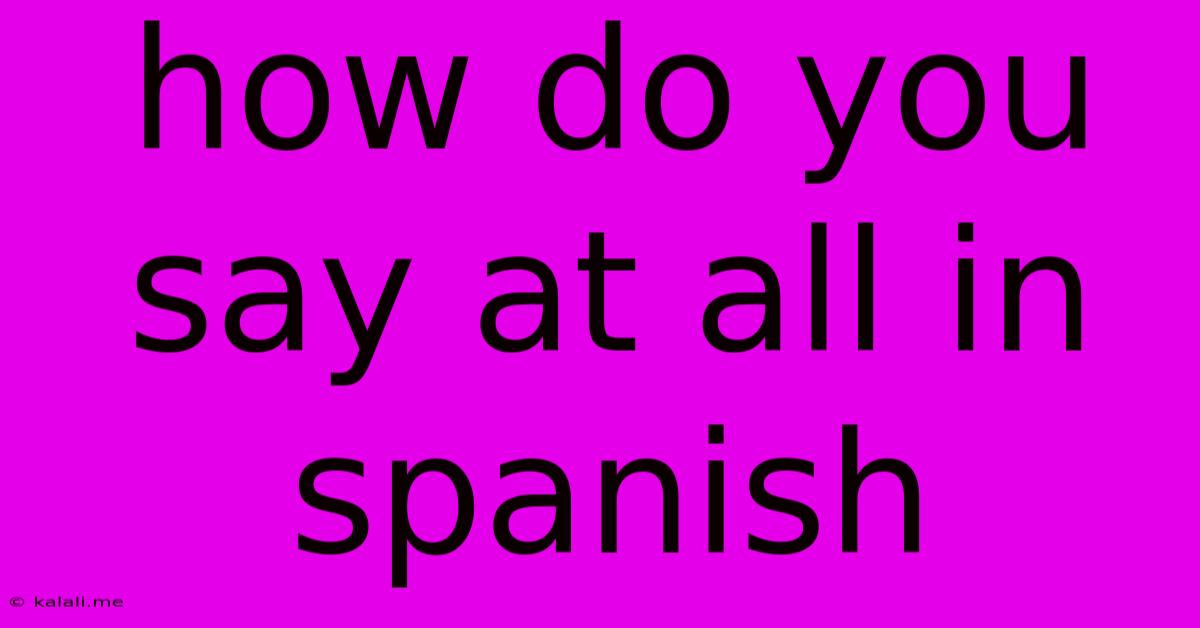How Do You Say At All In Spanish
Kalali
Jun 06, 2025 · 3 min read

Table of Contents
How Do You Say "At All" in Spanish? A Comprehensive Guide
Want to express the complete absence of something or emphasize a negative statement in Spanish? Knowing how to translate "at all" is crucial for fluent and nuanced communication. This guide explores various ways to say "at all" in Spanish, depending on the context and desired level of emphasis.
This article will cover different Spanish phrases that capture the meaning of "at all," including their subtle differences in usage and connotation. We'll explore the nuances of each option, helping you choose the most appropriate translation for any situation. Learn to speak Spanish with more confidence and precision!
Common Translations for "At All" in Spanish
The direct translation of "at all" doesn't exist in Spanish. Instead, the meaning is conveyed through different phrases, depending on the context. Here are some of the most common options:
-
Para nada: This is a very common and versatile way to say "not at all" or "in no way." It's suitable for most situations where you want to express a complete negation. For example: "¿Te gustó la película? Para nada." (Did you like the movie? Not at all.)
-
En absoluto: This phrase is more formal and emphatic than "para nada." It carries a stronger sense of absolute negation. For example: "¿Estás seguro? En absoluto." (Are you sure? Absolutely not.)
-
Ni un poco: This translates literally to "not even a little bit" and emphasizes the complete absence of something. It's useful when you want to strongly deny something. For example: "¿Tienes hambre? Ni un poco." (Are you hungry? Not at all/Not even a little bit.)
-
Nada: Simply "nothing" can often imply "not at all" in the right context. This is a more concise option. For example: "¿Hay algún problema? Nada." (Is there any problem? Nothing at all.)
Understanding the Nuances
The choice of phrase depends heavily on context and the desired level of formality and emphasis.
-
Formality: "En absoluto" is the most formal option. "Para nada" is suitable for most situations, while "ni un poco" can be slightly more informal depending on the tone.
-
Emphasis: "Ni un poco" adds a stronger emphasis on the completeness of the negation. "En absoluto" also carries a significant weight of emphasis.
Examples in Context
Let's examine how these phrases work in different sentences:
-
"I didn't like the food at all." Could be translated as: "No me gustó la comida para nada." or "No me gustó la comida ni un poco."
-
"He's not at all interested in politics." Could be translated as: "No está interesado en política para nada." or "No está interesado en política en absoluto."
-
"Is it difficult? Not at all!" Could be translated as: "¿Es difícil? ¡Para nada!" or "¿Es difícil? ¡Ni un poco!"
Beyond the Basics: Expressing Doubt or Disbelief
When expressing doubt or disbelief, other phrases can help convey the sense of "at all."
-
De ninguna manera: Means "in no way" or "absolutely not" and is a more emphatic way to express disbelief.
-
¡Qué va!: This is a more colloquial and informal expression of disbelief, similar to "no way!" in English.
By mastering these different expressions, you can confidently navigate the nuances of negation in Spanish and express yourself with greater precision and accuracy. Remember to consider the context and the level of formality when choosing the most appropriate phrase.
Latest Posts
Latest Posts
-
How Long Can I Keep Defrosted Chicken In The Fridge
Jun 07, 2025
-
Shower Leaking Into Outside Wall Carpet
Jun 07, 2025
-
My Cat Is Not Stimulated Vyb Anything
Jun 07, 2025
-
Microwave Transformer How Many Amps Out Put
Jun 07, 2025
-
Docketed New Case Ready For Examination
Jun 07, 2025
Related Post
Thank you for visiting our website which covers about How Do You Say At All In Spanish . We hope the information provided has been useful to you. Feel free to contact us if you have any questions or need further assistance. See you next time and don't miss to bookmark.